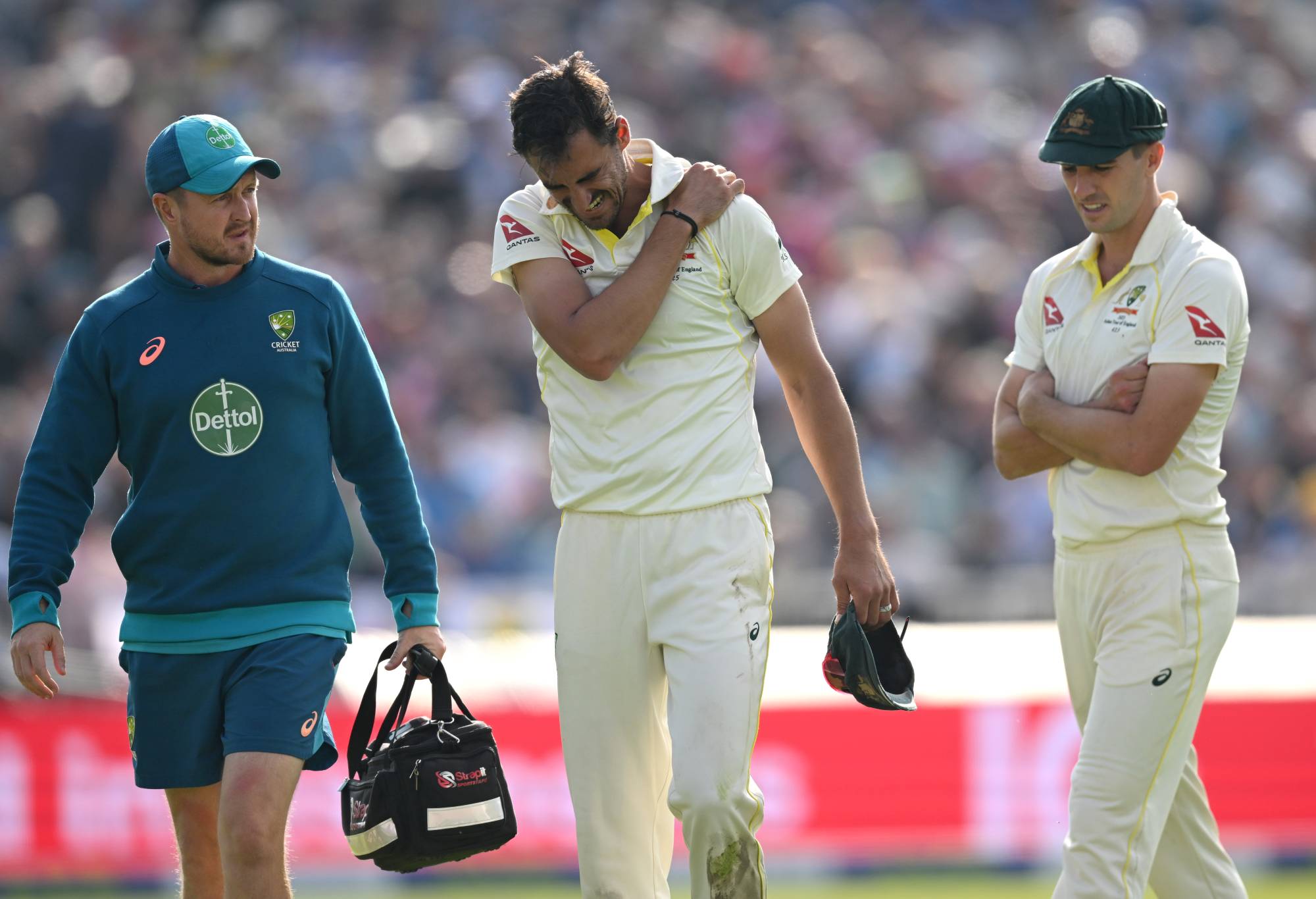Australia have defended their decision to go into Old Trafford without a spinner, insistent they are yet to see proof that the Manchester wicket will favour tweakers.
The tourists ended a nightmare second day firmly on the back foot in the fourth Ashes Test, with England 4-384 at stumps and leading by 67 runs.
Well behind in the game and with rain forecast for day four, Australia insist it is too early to start playing for a draw that will ensure they retain the Ashes.
They are also sweating on the fitness of Mitchell Starc with the left-arm quick exiting the field late in the day after hurting his left shoulder diving, before an attempted return lasted just three balls.
With Nathan Lyon injured and no Todd Murphy in the team, Starc, Pat Cummins and Josh Hazlewood were asked to get through the bulk of the work for Australia on Thursday.

Mitchell Starc holds his shoulder. (Photo by Gareth Copley/Getty Images)
Allrounders Mitch Marsh and Cameron Green bowled nine and 10 overs each, while part-time spinner Travis Head was smacked for 0-48 from six overs.
Also notable was the fact Head was brought into the attack after 22 overs on Thursday, eight overs earlier than when Murphy was used in the first innings at Headingley.
Australia’s decision not to play a spinner has already caused significant debate, particularly after Moeen Ali got some purchase for England on day one.
But regardless, coach and selector Andrew McDonald said there was nothing to suggest from the pitch yet that Australia had got their call wrong.
“We felt like on this surface, against this opponent, that spin wouldn’t play a huge part and we’re yet to see that,” McDonald told the BBC.
“I know Moeen took a wicket in the first innings, but we’ll never know what it would’ve looked like with a spinner today.
“We went with a different attack and we’ve got to focus on the bowlers we’ve got.”
Australia’s decision to go without Murphy came after he was limited to 9.3 overs across two innings at Headingley, while Marsh scored a century filling in for an injured Green.
Assistant coach Dan Vettori said on Thursday it was still too early to judge if Australia’s call was the wrong one.
“With the thoughts on the wicket and with potential weather conditions around, we potentially thought the Test match would be of a shorter nature,” the former New Zealand spinner said. “And also the way England play, how aggressive they are, it can shorten the game up a bit.
“It’s a selector’s call, but it’s one of the ones we will judge at the end of the Test match, not two days in.”
Australia are hopeful Starc will be able to bowl on Friday, but with a short turnaround before the fifth Test the situation has the potential to be a concern.
“He’s currently got some ice on it and we’re pretty confident it will be right tomorrow,” Vettori said. “He wanted to get on the field as quickly as possible to see how it was.
“But three balls in a row came to him in the field and he didn’t quite feel comfortable throwing it.”
Starc (2-74) had earlier been spotted grabbing at his left hamstring while bowling and looking ginger, but Australia also played down those concerns.
Leading the Ashes 2-0 a fortnight ago, Australia are now at risk of heading to The Oval for next week’s series finale at 2-2. Their only saviour may be rain, which is forecast for the whole of day four, given a draw will be enough to retain the Ashes.
But England’s efforts to move the game on quickly after bowling Australia out for 317 now has the hosts aiming to bat only once in the match.
The hosts scored at a rate of 5.34 an over on Thursday, as Crawley and Joe Root plundered the tourists to all corners of Old Trafford.
Crawley’s 182-ball knock featured 21 boundaries and three sixes, and by the time he eventually chopped on, trying to pull Cameron Green, England were in complete control.
It came as part of a 178-ball 206-run third-wicket partnership with Root, who was eventually bowled by a Josh Hazlewood ball that stayed at ankle height for 84.
But as well as the pair batted, Australia’s showed signs of being rattled by the hosts.
Pat Cummins dropped one catch and completely missed another, while wicketkeeper Alex Carey also put down an extremely tough chance off Crawley’s inside edge on 42.
Australia’s captain also let two overthrows through in the final session as he failed to back up a Steve Smith throw, in an uncharacteristic show of sloppiness.
While Starc found opener Ben Duckett’s edge early in the innings, for one, and snared makeshift No.3 Moeen Ali pulling for 54, Australia’s bowling was the worst it has been all series.
They were too straight to Crawley, going away from trying to take his edge outside off stumps with little seam movement on offer.
Their short balls were also often not short enough, allowing Crawley and Root to regularly pull and hook to the gaps in the legside field.

Zak Crawley celebrates reaching his century. (Photo by Martin Rickett/PA Images via Getty Images)
Part-timer turned first-choice spinner Travis Head was called into the attack by the 23rd over and was immediately attacked by Crawley. Head finished with 0-48 off six overs.
Crawley’s 93-ball century was the second fastest in all Tests played at Old Trafford, during a particularly damaging middle session where England scored 178 runs in 25 overs.
“In the back of our minds we always knew England had this in them because they play so aggressively,” Vettori said.
“It was a pretty flat surface, there wasn’t a lot of seam or swing on offer. Today was the perfect storm of them coming hard at us, and us not being able to come back against them with wicket-taking options.”
>Cricket News

%20(3).jpeg)



%20(3).jpeg)
0 Comments